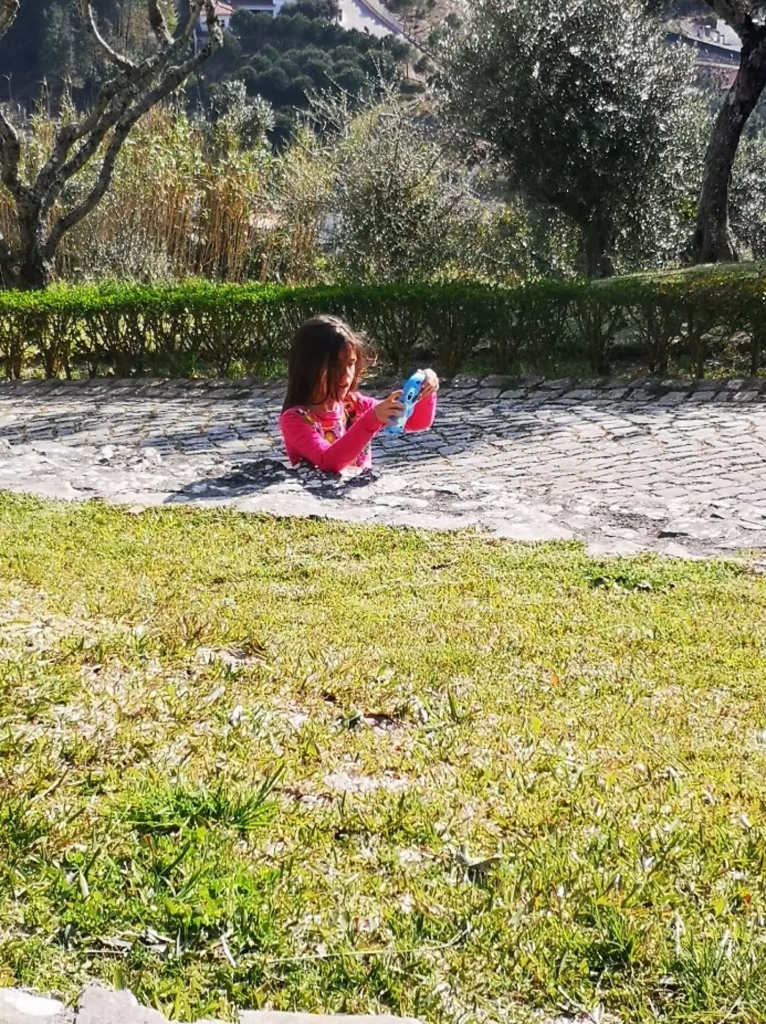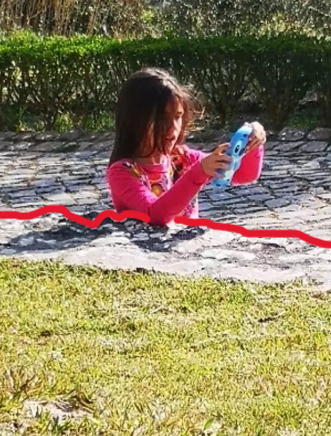In a world of endless scrolling and countless images, it’s rare for a photo to stop us in our tracks. But a seemingly ordinary picture of a young girl playing outside has done just that, sparking confusion, fascination, and endless debate across the internet. At first glance, the girl appears to be partially “sinking” into the ground, as though half her body has mysteriously disappeared. But what’s really going on here? Let’s dive into the optical illusion that has everyone talking.
The Viral Optical Illusion: A Mind-Bending Mystery

This puzzling photo, originally posted on Reddit by the girl’s father, took social media by storm. It shows a young girl playing, but with one curious twist—half of her body seems to vanish into the ground. Thousands of viewers have found themselves scratching their heads, convinced there’s some glitch in reality or a clever digital edit at play.
Her father added to the intrigue with a playful caption: “My daughter, where’s the rest of her?! Ohh I see, do you?” Within hours, the post had attracted thousands of comments as users tried to unravel the mystery. So, what’s causing this mind-bending visual effect?
Why This Image Is So Confusing: The Power of Perspective
Our brains love familiarity, especially in familiar scenes like a yard or playground. When we see a child standing or sitting on the ground, our brain instinctively expects their full body to be visible. This expectation becomes the trap. The illusion works because it exploits our brains’ natural assumptions, prompting us to see something that isn’t there—or in this case, fail to see something that is.
In this image, a cleverly hidden wall blends almost seamlessly with the ground, creating the illusion that the girl’s lower half has “sunk” into the ground. The angle of the photo and the matching textures of the wall and pavement make it nearly impossible to notice the elevation change at first glance.
Common Misconceptions About the ‘Sinking Girl’ Illusion
When viewers encounter this image, they often make a few common assumptions that add to the confusion:
- Assuming a Continuous Surface: Many viewers interpret the ground as one continuous level, leading them to overlook the possibility of a hidden wall or height difference.
- Expecting a Complete Figure: People naturally expect to see the entire body of the girl, so when half of her seems missing, their minds go straight to strange explanations.
- Ignoring the Possibility of Elevation: Because most people don’t expect walls or pavements to blend seamlessly, they’re unlikely to consider that a change in height could be the culprit. The illusion capitalizes on this assumption to trick the viewer’s eye.
A Step-by-Step Guide to Solving the Optical Illusion
To unravel this puzzling image, let’s break it down, step by step:
1. Start by Observing the Girl’s Position
First, look at the girl’s posture and position. She’s sitting comfortably, with her arms visible. Her relaxed pose indicates she’s not in any danger or genuinely “sinking.”
2. Analyze the Ground Around Her
Take a closer look at the area around her lower body. You’ll notice that where her legs should be, there’s a seamless blend with the pavement. This blending effect gives the illusion that her legs are missing.
3. Spot the Hidden Wall
The key to solving this illusion is identifying the hidden wall in front of her. The pavement she’s standing on actually sits a level lower than the grassy area and the pathway behind her. This elevation difference, combined with the alignment of the wall, tricks the eye into perceiving her as part of one continuous surface.
4. Recognize the Perspective Trick

The father’s choice of angle makes this illusion so effective. The wall’s colors and textures match the surrounding pavement, so it blends almost perfectly with the background. From his perspective, the wall aligns seamlessly with the ground, effectively concealing the true depth.
Why Optical Illusions Like This Fool Us So Easily
Optical illusions like this one mess with our minds by playing on our brain’s natural assumptions and expectations. Since we don’t often encounter walls that blend this well with the ground, we’re more inclined to accept what we see at face value. Our brains take mental shortcuts, filling in gaps to create a coherent scene—especially in familiar settings. In this case, that shortcut leads us to the “sinking” illusion.
Even the father’s playful caption primes us to look for something unusual about the girl’s body, adding an extra layer of confusion. Without the caption, some viewers may have been more likely to spot the wall. This illusion is a perfect example of how small, hidden details can alter our entire perception of an image.
Social Media’s Reactions: Hilarious and Clever Responses
Of course, social media couldn’t resist weighing in on this mind-bending illusion. Viewers offered plenty of funny interpretations and creative theories to explain the “missing” body:
- “You took ‘grounding your kids’ to a whole new level!” one user joked.
- Another chimed in, “Another teleporter malfunction! When will Starfleet learn?”
- A baffled commenter added, “I’ve stared at this for minutes and still can’t figure it out.”
While some users quickly identified the hidden wall, others took longer, only realizing the solution after reading hints in the comments. Many compared this illusion to those classic Magic Eye puzzles that reveal hidden images after a few moments of focus.
The Science Behind Why We Love Visual Puzzles
So, why are we so fascinated by illusions like this? Perspective tricks captivate us because they challenge our assumptions about the world. These illusions play on our brains’ tendency to interpret images based on what we expect to see, not necessarily what’s there. When our expectations clash with reality, we experience a moment of cognitive dissonance—a small “glitch” in understanding that’s both frustrating and delightful.
Illusions force us to slow down, look closer, and question our assumptions. That’s why puzzles like this are more than just fun; they’re also exercises in perception, encouraging us to think outside the box and be more observant.
Wrapping It Up: Did You Spot the Hidden Wall?
So, did you spot the hidden wall on your own, or did it take you a while? Optical illusions like these test our ability to notice subtle differences and to look beyond the obvious. They’re a great reminder that there’s often more to an image—or a situation—than meets the eye.
If you enjoyed this optical puzzle, consider diving into more illusions and perspective tricks. They’re a fun way to train your brain to see beyond the surface and to sharpen your observational skills. After all, in a world filled with hidden details, sometimes a fresh perspective can make all the difference.


